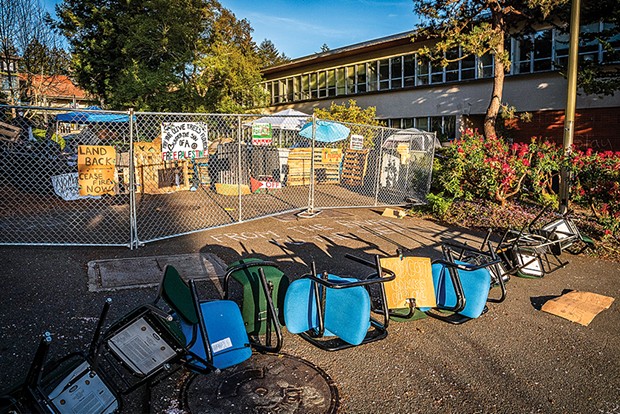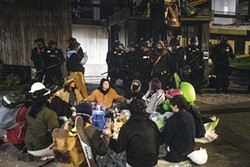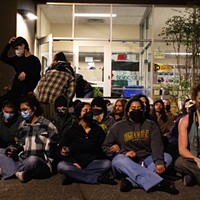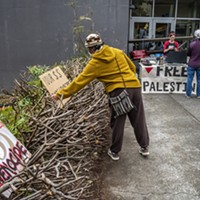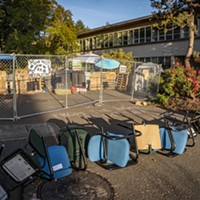'On Siemens Hall Hill'
How an eight-day occupation at Cal Poly Humboldt divided campus
By Thadeus Greenson [email protected] @ThadeusGreenson[
{
"name": "Top Stories Video Pair",
"insertPoint": "7",
"component": "17087298",
"parentWrapperClass": "fdn-ads-inline-content-block",
"requiredCountToDisplay": "1"
}
]
When a group of several dozen protesters entered Siemens Hall on the Cal Poly Humboldt campus shortly before 5 p.m. on April 22, they say they had no intention of grinding the university's operations to a halt. Standing on the campus quad, which was barricaded on all sides with makeshift blockades crafted out of segments of fencing, chairs, tables, dumpsters, newspaper racks, picnic benches and other debris chained together, a woman who would only identify herself as Trillium says the plan had been to start with a seder dinner.
Trillium says a "big group" had gotten together the day before, wanting to plan some kind of action that would draw attention to the growing humanitarian crisis in the war in Gaza. Because a number of the group members are Jewish, Trillium says they supported the idea of doing something to coincide with the Passover holiday that would bring awareness to the ongoing war and the devastation it was causing, and show people of multiple faiths standing together in solidarity with the Palestinian people.
So they entered the building with matzah ball soup, bitter herbs and other components of the meal.
"We were planning to have a sit-in, an open occupation," Trillium says, noting that, as they envisioned it, the direct action wouldn't encroach on classrooms and would leave the building open for students and administrators to come and go. "I went out to get supplies and when I came back, there was a riot squad outside."
It's unclear exactly what happened in the first exchanges between police and the protesters, but police attempted to clear the building, evacuating five classrooms, and then ordering protesters to leave. When they refused, police prepared to remove them. As police readied outside, the protesters attempted to barricade the doors in an effort to "protect the space," Trillium says.
What ensued, captured on video by local reporter Ryan Hutson, was ugly. Police with riot shields tried to push through the building's main entrance, which opens on the quad, and protesters pushed back, causing a scrum at the doors. A protester can be seen in the video using an empty 5-gallon plastic water jug to hit a helmet-clad officer over the head, while an officer can be seen swinging his baton into the crowd and another officer delivers multiple blows with his elbow. Protesters yell, "Get the fuck out," in the background over the din of screams and shouts of, "You're beating students." The officers then slowly retreat.
Outside, the situation escalated into a tense standoff, with students and community members trying to form a human shield between officers and those inside Siemens Hall. Officers were called in from multiple local agencies and a California Highway Patrol helicopter circled overhead. The university, meanwhile, announced campus would be closed for the next two days, stressing it was "deeply worried about the safety of the students who remain in the building."
Then shortly before 11 p.m., someone apparently made the call for officers to stand down, and they disbanded, leaving the center of campus to the protesters. Numerous Journal inquiries to the university and the California State Chancellor's Office asking who was in command of the law enforcement action that night have not been answered.
By morning, Siemens Hall's four entrances were thoroughly blockaded, and a community group Humboldt for Palestine relayed occupiers' reported demands: that the university divest from all ties to "Zionist" entities and companies complicit in the "occupation of Palestine;" that it cut ties with Israeli universities; that it call for an immediate ceasefire; and that it drop all "charges and attacks on" student organizers.
The occupation had begun.
The ensuing week would cause — or in some cases perhaps just widen — deep divisions on campus.
Faculty and staff were sharply critical of administrators handling of the initial protest and the decision to have police clear the building, and their ensuing decision to close campus through May 10, moving all courses and finals online, creating chaos for teachers and students alike.
In a no-confidence vote in President Tom Jackson Jr. and his chief of staff Mark Johnson on April 25, the Humboldt General Faculty Union would criticize what they deemed an "disproportionate police response" that created "unnecessary escalation," and demanded the university not pursue disciplinary actions or criminal charges against any students connected to the protests. The same day, in an interview with the Times-Standard, Jackson said protesters contining to occupy portions of campus weren't "there for noble causes," calling them "criminals."
The same day, other campus administrators met with protesters to discuss their demands and concerns. Administrators informed them that the university's investments follow an "environmentally and socially responsible" strategy crafted in 2014 with student input. Because most of the university's investments are in mutual funds — bundles of stocks and interests in many different companies — they said it was hard to come up with precise numbers, but estimated "conservatively" that less than 1 percent of its more than $51 million portfolio is in potential defense investments or Israeli companies and organizations. While the university is committed to global engagement, administrators said it does not currently have any ties to Israeli universities. As to dropping charges against organizers, officials reported said there would be consequences for those who violate the law or university policy, though those could be mitigated some for students who elected to leave Siemens Hall on their own accord. On the subject of calling for a ceasefire, the university proved unwilling to go that far, instead issuing a statement that it is "supportive of a peaceful and just world which affords the opportunity for all human beings to flourish and achieve their potential."
Some progress, it seemed, was being made, and the university issued a press release April 26 noting the protests had "elevated a remarkable number of important questions, opened a space for difficult, meaningful conversation." Several hours later, it began sending notices of suspension to students identified as having participated in the occupation of Siemens Hall or who were camping adjacent to it. That afternoon it gave students a three-hour safe harbor timeframe to leave the campus buildings without facing arrest, so long as they registered with officials upon their exit with no guarantee they wouldn't' face disciplinary action.
Mad River Community Hospital was apparently so alarmed at what might happen, fearing a mass injury event might follow the end of this safe exit period, that it instated a partial hospital lockdown, preparing for an influx of patients that never came.
That evening, those occupying Siemens Hall opened it to the public, and a stream of community members and students toured through the building the occupation of which had been the subject of pervasive debate and discord for days. While structural damage to the building seemed fairly minimal. Graffiti was widespread in certain areas, especially Jackson's office, where someone had scrawled "Blood on Your Hands" in blue spray paint over a wall hanging and "I Will Live Free or Die Trying" in green on a door on the opposite wall. "U R Ugly" had been painted on an office mirror.
In the building's main second story hallway, someone had written "Cops Beat Students Here," in Sharpie, with the words "Free Gaza," "Divest" and "Stop Genocide" also appearing in various locations.
While the administration had raised concerns that confidential files housed in the building could be compromised by the occupation, no such evidence was reported. According to the faculty union, nearly all administrative offices in the building remained securely locked.
Around 12:30 p.m. the following day, Saturday, April 27, the university advised faculty and staff that the campus was being put under a "hard" closure. Students living in residence halls would be allowed to remain, but would be restricted to their residences and dining halls, while all others would face citation or arrest for being on campus. An increased law enforcement presence was then seen on campus. Protesters re-established the barricades blocking the entrances to Siemens Hall, with an unknown number of inside.
Tensions again began to ramp up among protesters who said they expected another police enforcement action was imminent.
CPH's pro-Palestinian protest, of course, did not come in a vacuum. It instead grew as a part of scores of similar occupations and protests on college campuses across the nation. Even on the Arcata campus, views diverged sharply about the propriety of the protests and administration's response to them.
A Jewish student interviewed by the Journal said they found the graffiti spray painted on some campus buildings reading "From the River to the Sea" offensive, saying they believed it to be a call to destroy Israel or even kill or run off its Jewish inhabitants. Another, however, said they just saw it as a call for freedom for Palestinians, saying it didn't bother them. Both declined to be identified.
On the other end of campus, in front of one of the CPH gateway entry signs, a woman in a white dress and platform heels posed in a mortar board hat with a bottle of Champagne for photos, apparently resigned to miss graduation day.
Over by the residence halls, a freshman ecology student who declined to be identified, said she'd been unnerved by the occupation, noting she had to pass through a blockade to make it from her room to the market hall and it felt unsafe. She said she tried to engage with protesters to understand their views. "Some were nice," she said, adding others were not. Her friend, a wildlife conservation major who also declined to be identified, said she suffers from anxiety and had basically spent the last week holed up in her room on campus afraid to leave. Both say they feel administration has acted appropriately faced with a challenging situation.
The ecology major's mother, up from Lake County to pick her up, said she grew concerned watching the scene unfold from afar in the news and via social media.
"Protesting is supposed to be peaceful and vandalizing things isn't peaceful," she said, reflecting on her feelings. "It was stressful."
Launa Wyrd, an Arcata resident, felt differently. She said she saw news about the police crackdown of protesters on April 22 and came to campus the next morning to see what was happening. She became inspired.
"What's happening here is incredible," she said, adding that she eventually set up a tent as a part of the occupying encampment Sunday. "I kept coming back because I see what these people are doing and the world they're trying to create. ... I'm here because I live a mile away and felt my community needed me, and I feel the world needs us."
Asked about administration's response to the protests, Wyrd says it has been disproportionate, noting she and others have been declared "criminals" for gathering in a space in front of the student activities building the university recently renamed Gutswurrak, the Wiyot word meaning "gathering place." But most of all, Wyrd says she's mystified Jackson had seemingly made no attempts to speak to protesters directly.
"Come and have a cup of tea with us — come see what we're about," she says.
On the quad in the heart of the occupied area, a student looking at her phone almost bumps into a friend. "I'm in a Zoom class right now talking about what to do if we get arrested," she says with a chuckle.
Over by the Mutual Aid Kitchen and a nearby medical tent, Trillium says this space — shared among protesting students and folks like Wyrd — has become a community.
"We've been able to feed hundreds of people three meals a day," she says, noting that the effort has been entirely volunteer-led and donation based. "It sounds cheesy but the power of home and the power of love and the power of community — I've felt that so strongly this past week."
Asked about administration's response to the protests, Trillium says it's been a gross overreaction with reverberating impacts, noting none of the protesters wanted to stop people from celebrating their graduation or going to class.
"I would like my classes to be ongoing," she says. "My original plan was to come hang out at Siemens Hall between classes."
As to what she's hoping the occupation can attain, Trillium says different people have different aims, though she's hoping it can be one of a growing number of voices that could make a ceasefire in Gaza possible.
"I don't want to die on Siemens Hall hill," she says. "I don't care about Tom Jackson. I mean, he sucks and everyone knows it, but I'm here to stand with Palestine, and it's incredible to feel part of something bigger. ... I don't need everyone to lock arms with me but I do want them to give us a chance."
Around 9 p.m. on April 29 — just a handful of hours after Trillium and Wyrd spoke to the Journal on the campus quad — patrol vehicles showed up at the already blockaded entrances to CPH, and various other locations throughout campus, their megaphones blaring a recording on repeat.
"Break up this assembly and leave the area," it said. "If you do not do so, you may be arrested. You may also be subject to other police action, including the use of kinetic energy projectiles and chemical agents."
Coming on the heels of rumors throughout that large out-of-area law enforcement convoys had been spotted heading to Humboldt County north on U.S. Highway 101 and west from Redding, the megaphone announcements seemed a clear sign that an enforcement action was imminent. But it wasn't until about five hours later — after busloads of police officers had arrived from more than a dozen agencies — that officers moved in.
First there were the sounds of chainsaws and power tools as officers dissembled the blockades and moved to surround the quad, where a couple dozen protesters had sat in a circle with interlocked arms chanting pro-Palestinian phrases. One by one, the officers began pulling the protesters to their feet, zip tying their hands and detaining them for processing.
After a handful of protesters were taken into custody, a line of dozens of officers in full riot gear began moving forward, shoulder to shoulder, batons in hand, physically clearing onlookers and media from the quad area. Police continued on until they'd pushed them through library circle and off campus, repeating "clear the area."
A CPH press release several hours later reported about 25 people were arrested "without incident," adding "there were no injuries." Online jail booking reports, however, only list four people booked into the jail, including Wyrd.
The press release includes a quote from Jackson, his first to local media or the campus community (other than the Times-Standard interview) addressing the situation.
"This is a difficult day, it breaks my heart to see it, and truly nobody wanted to see things come to this," he said. "We've all watched this with great concern, and always with the sincere hope that it would be resolved peacefully. Unfortunately, serious criminal activity that crossed the line well beyond the level of a protest had put the campus at ongoing risk. I commend the law enforcement team for their effort in resolving this very dangerous situation, and I'm incredibly grateful for the many agencies who advised us and who came to our aid in our time of need. I'm also very grateful for our many staff members who performed far and above their normal duties to help us protect the campus and maintain operations. Our focus for the entire time has been on doing all we could do to protect the safety of all involved, and we were very patient and very disciplined with that."
Within hours of the news release, the local faculty association chapter had issued a statement condemning the clearing of campus as "another dangerous escalation."
Thadeus Greenson (he/him) is the Journal's news editor. Reach him at (707) 442-1400, extension 321, or [email protected].
Comments (3)
Showing 1-3 of 3
more from the author
-
'False Narratives'
Tom Jackson Jr.'s chief of staff offers defiant defense of university's handling of protests
- May 16, 2024
-
Document Sheds Light on Arcata Principal's Reassignment
Written reprimand accuses Perry of failing to follow the law, district policy
- May 16, 2024
-
Sheriff's Office IDs Deputy Who Shot Suspect
- May 13, 2024
- More »
Latest in News
Readers also liked…
-
Through Mark Larson's Lens
A local photographer's favorite images of 2022 in Humboldt
- Jan 5, 2023
-
'To Celebrate Our Sovereignty'
Yurok Tribe to host gathering honoring 'ultimate river warrior' on the anniversary of the U.S. Supreme Court ruling that changed everything
- Jun 8, 2023
